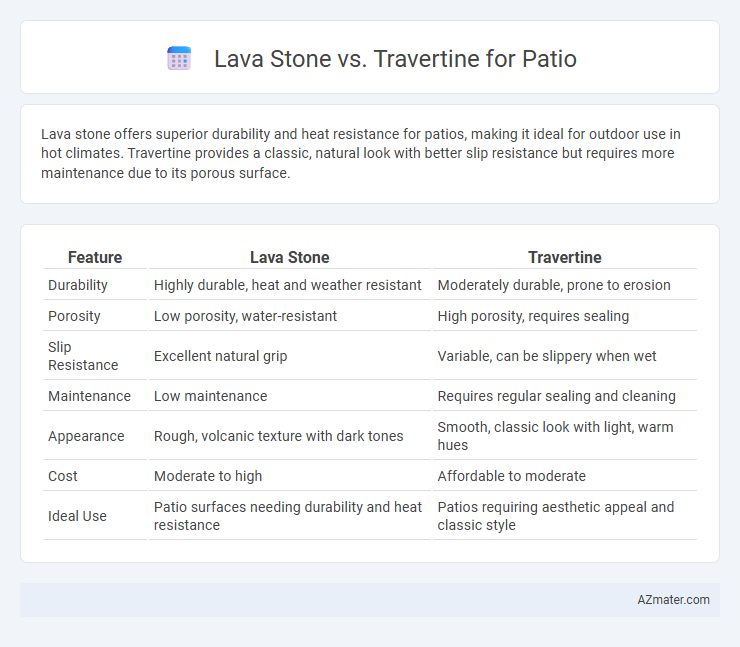Lava stone offers superior durability and heat resistance for patios, making it ideal for outdoor use in hot climates. Travertine provides a classic, natural look with better slip resistance but requires more maintenance due to its porous surface.
Table of Comparison
| Feature | Lava Stone | Travertine |
|---|---|---|
| Durability | Highly durable, heat and weather resistant | Moderately durable, prone to erosion |
| Porosity | Low porosity, water-resistant | High porosity, requires sealing |
| Slip Resistance | Excellent natural grip | Variable, can be slippery when wet |
| Maintenance | Low maintenance | Requires regular sealing and cleaning |
| Appearance | Rough, volcanic texture with dark tones | Smooth, classic look with light, warm hues |
| Cost | Moderate to high | Affordable to moderate |
| Ideal Use | Patio surfaces needing durability and heat resistance | Patios requiring aesthetic appeal and classic style |
Introduction to Lava Stone and Travertine Patios
Lava stone patios offer exceptional durability and natural heat resistance due to their volcanic origin, making them ideal for outdoor spaces exposed to high temperatures. Travertine patios provide a classic, elegant appearance with a porous, smooth texture that remains cool underfoot even in hot weather. Both materials are popular choices for patios, but lava stone excels in strength and thermal properties while travertine is favored for its aesthetic appeal and comfort.
Aesthetic Differences: Lava Stone vs Travertine
Lava stone offers a bold, rugged aesthetic with its porous texture and deep, volcanic hues ranging from black to dark gray, creating a natural, dramatic look ideal for modern or rustic patios. Travertine presents a softer, more classic appearance with its smooth surface and warm earth tones like beige, cream, and light brown, featuring characteristic natural veining and pitting that adds elegance and timeless appeal. Choosing between lava stone and travertine ultimately depends on the desired patio ambiance--lava stone for striking, edgy designs versus travertine for subtle, refined outdoor spaces.
Durability and Weather Resistance
Lava stone boasts exceptional durability and weather resistance, with its volcanic origin giving it a naturally porous yet strong composition that withstands extreme temperatures and moisture without cracking. Travertine, a sedimentary rock, offers moderate durability but is more susceptible to weather-induced wear such as erosion and staining, requiring regular sealing to maintain its integrity. For patio applications exposed to harsh climates, lava stone is generally favored due to its robustness and low maintenance needs compared to travertine's higher upkeep requirements.
Surface Texture and Comfort Underfoot
Lava stone patios offer a unique porous surface texture that provides excellent slip resistance and remains cool underfoot, making it ideal for warm climates. Travertine features a smooth, slightly pitted texture with natural grooves, contributing to a comfortable walking experience while allowing for effective water drainage. Both materials balance aesthetics and functionality, but lava stone's rugged surface enhances grip, whereas travertine provides a softer, more refined feel.
Slip Resistance and Safety Factors
Lava stone offers superior slip resistance for patios due to its naturally rough and porous surface, making it an excellent choice for wet or humid environments. Travertine, while aesthetically pleasing with its smooth and polished finish, tends to be more slippery when wet, requiring additional treatments or mats to enhance safety. Selecting lava stone significantly reduces the risk of slips and falls, providing a safer outdoor space for families and guests.
Maintenance and Cleaning Requirements
Lava stone patios require minimal maintenance due to their natural resistance to stains, heat, and weather, making them ideal for outdoor use with effortless cleaning using just water and mild soap. Travertine, while elegant, demands more frequent sealing to protect its porous surface from stains and weather damage, along with gentle cleaning methods to avoid surface etching. Regularly scheduled sealing and pH-neutral cleaners help preserve travertine's durability and aesthetic appeal over time.
Cost Comparison: Installation and Materials
Lava stone patios typically cost between $15 and $30 per square foot for materials and installation, making them a mid-range option known for durability and heat resistance. Travertine patios average $20 to $45 per square foot, with higher-end prices attributed to its natural beauty and slip-resistant surface. Installation expenses vary due to material density; lava stone's porous texture requires sealing and meticulous fitting, while travertine's softer composition demands skilled labor to prevent chipping, impacting total costs.
Environmental Impact and Sustainability
Lava stone is an eco-friendly patio material due to its natural origin and minimal processing, resulting in lower carbon emissions compared to travertine, which requires extensive quarrying and processing. Lava stone's durability and porosity reduce water runoff and increase sustainability by promoting natural water absorption. Conversely, travertine mining often disrupts ecosystems and generates significant waste, impacting environmental sustainability negatively.
Best Applications for Each Stone
Lava stone's porous texture and high heat resistance make it ideal for outdoor patios in hot climates, providing natural slip resistance and durability against weather elements. Travertine, with its classic look and smooth surface, excels in poolside patios and shaded garden areas, offering cooler underfoot temperatures and elegant aesthetics. Both stones are low-maintenance, but lava stone is better suited for rougher terrains, while travertine suits refined, formal outdoor spaces.
Which Patio Stone is Right for You?
Lava stone offers unparalleled durability and heat resistance, making it ideal for patios exposed to intense sun and heavy foot traffic, while travertine provides a classic, elegant look with natural porous textures that stay cool underfoot. Both materials are slip-resistant and weather-tolerant, but lava stone excels in low maintenance and long-lasting strength, whereas travertine requires periodic sealing to preserve its appearance. Choosing between lava stone and travertine depends on whether you prioritize rugged resilience or timeless aesthetics for your outdoor living space.

Infographic: Lava stone vs Travertine for Patio
 azmater.com
azmater.com